Udaipur is Rajasthan’s Lake City, but it could also be called Palace City as there are many charming, historical palaces and Havelis within Old Town. It’s a great place to spend a few days, soaking in the history.
Udaipur’s Old town is a maze of narrow streets haphazardly climbing up and down the small hills around its main buildings, City Palace and Jagdish Temple. The tight streets are filled with old buildings, many dating back to the 1600s. Some have been well maintained and are in excellent condition, others are in disrepair. No matter their condition, all are being used today as homes, shops and dingy cafes. As you move closer to the palace, they are used for tourist-friendly restaurants and hotels. It’s a lively area with a lot of character. You can see though, from the electrical wiring, why we had frequent blackouts in India.
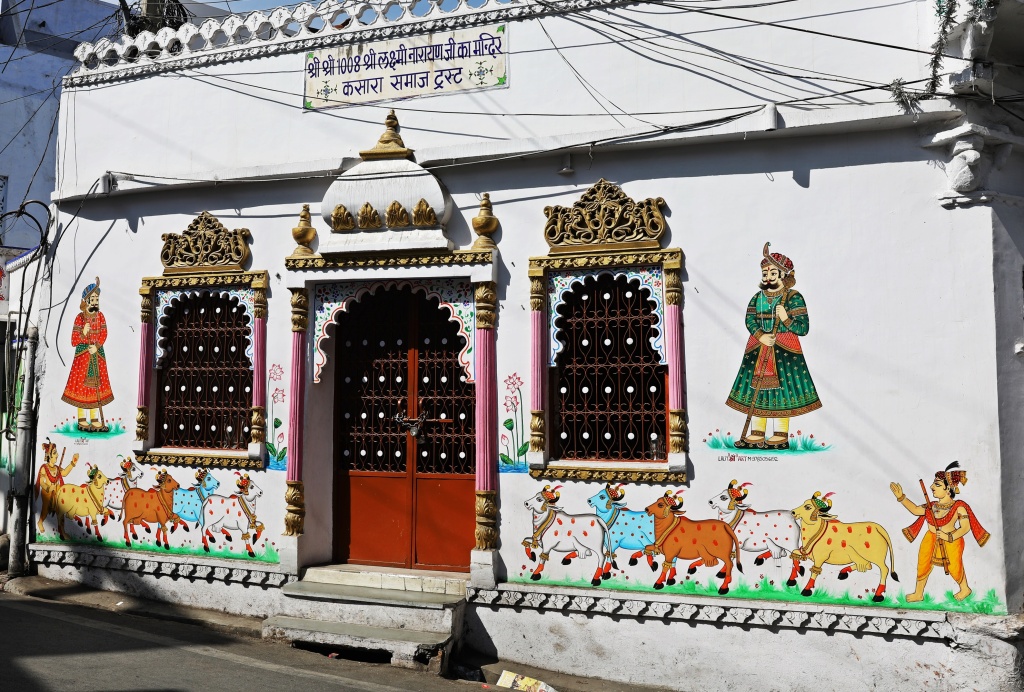
Street art,f Udaipur 
Streets of Udaipur 
Streets of Udaipur 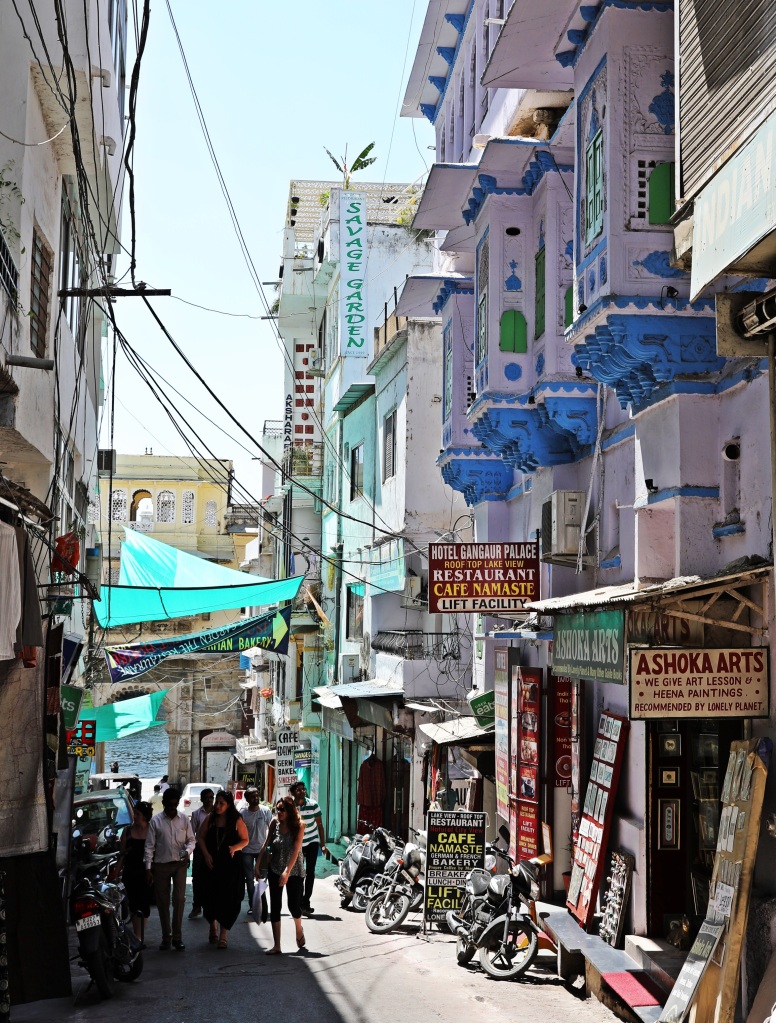
Buildings, Old Udaipur 
Street art, Udaipur 
Crazy electrical wiring, Udaipur 
HIndu temple, Udaipur 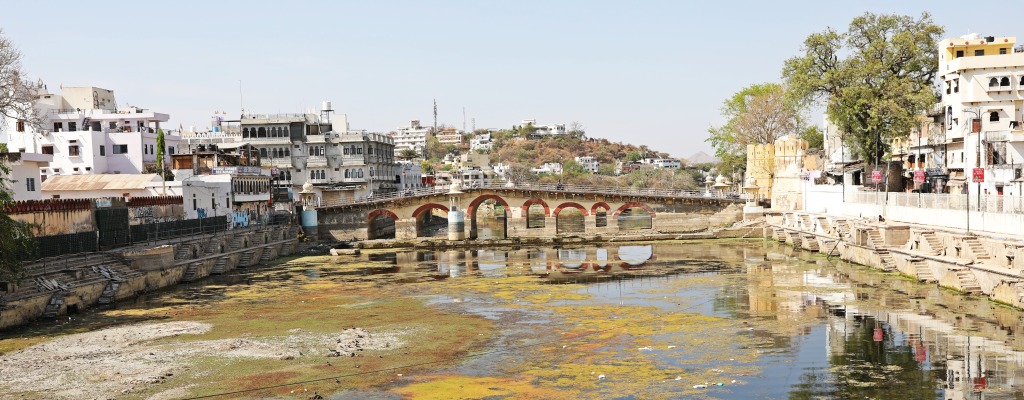
Old bridge over the dry Lake Pichola 
City Gate, Udaipur
Set beside the large, but shallow man-made Lake Pichola, City Palace was first built in in the 1600s. Many additions were built on to it over the centuries by generations of Maharajas (kings). Today it’s a stunning building with elaborate cupolas, towers, turrets and, balconies. The design details include stained glass, colourful tiles and detailed carvings. The palace is entered through three large gates passing lovely garden courtyards. At the side of one entrance are eight marble arches. They represent the eight Maharajas who donated their weight in gold or silver to the citizens of Udaipur during their reign. Toran Pol is the final colourful gate that leads to the Palace’s interior. It has painting of Surya, the sun god, on the top.

Tripolia Gate, City Palace, Udaipur 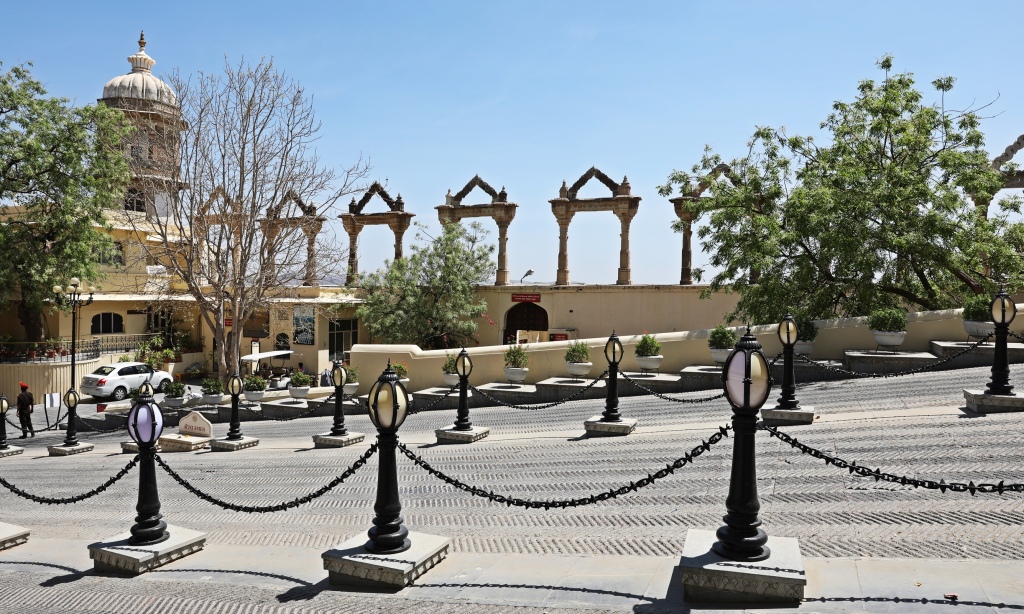
Eight marble arches, City Palace, Udaipur 
Canons and eight arches, CIty Palace, Udaipur 
City Palace and Manek Chowk, Udaipur 
Elaborate balconies, City Palace, Udaipur 
City Palace and Manek Chowk, Udaipur 
Toran Pol, City Palace, Udaipur 
Rajasthanis, City Palace, Udaipur 
Gate, City Palace, Udaipur 
Tailor, City Palace, Udaipur
Inside the gates, the first palace rooms you enter, are finished in white marble and are decorated with incredibly detailed carved doorways and window frames. The windows have colourful stained glass which is common in Rajasthan. As we walked through the palace, we saw many rooms that are colourfully tiled or brightly painted in blue, green or orange. Throughout the palace are countless elaborate windows and pretty balconies offering great views of the sprawling city on one side and the lake on the other.

Marble archways, City Palace, Udaipur 
Elaborate marble carvings, City Palace, Udaipur 
Nursery, City Palace, Udaipur 
Colourful ceiling, City Palace, Udaipur 
Colourful room in City Palace, Udaipur 
Colourful room in City Palace, Udaipur 
Room in City Palace, Udaipur 
Cookware, City Palace, Udaipur 
City Palace, Udaipur 
Tiled balcony, City Palace, Udaipur 
Udaipur and our hotel roof seen from City Palace 
Elaborate balcony, City Palace, Udaipur 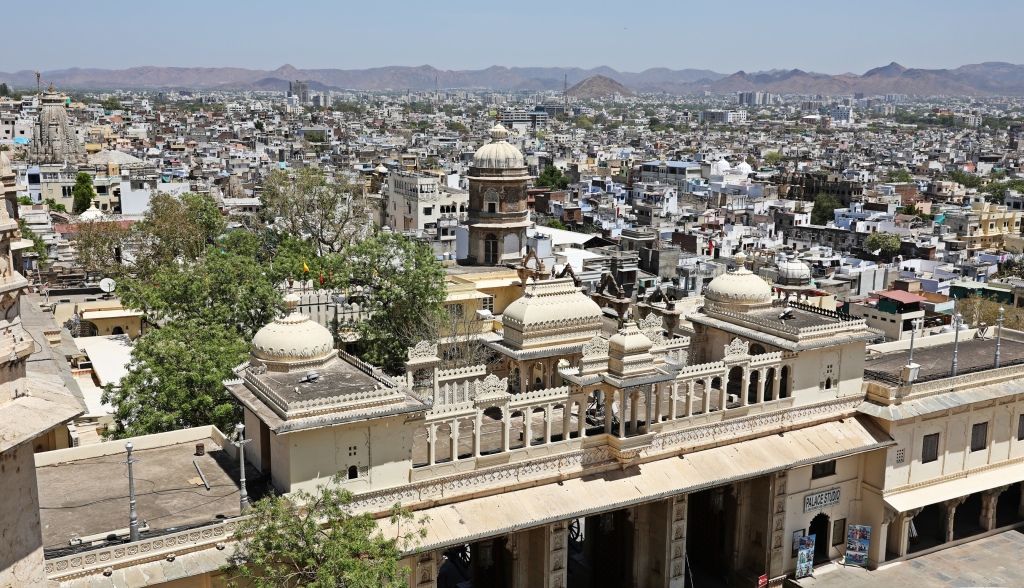
view of Udaipur from the Palace 
Colourful tiles in a courtyard, City Palace, Udaipur 
Lake Pichola and mountains of the Aravalli Range 
Lake Palace on Lake Pichola, Udaipur
There are many open-air courtyards, with covered walkways and pavilions inside City Palace. In the middle of the place is Badi Mahal (Garden Palace). Its enclosed courtyard with large trees and marble benches is a tranquil spot. There are several chhatris and balconies on the roof of the surrounding walkway. Laxmi Chowk (courtyard) is a large courtyard with elegant moldings on the eaves of the covered walkway. In the middle of the courtyard is a gorgeous white pavilion with a a fancy domed roof. A room just off Laxmi Chowk has paintings of the previous ruling Maharajas, who all had fantastic, fashionable beards.
City Palace is a popular tourist site. When we were visiting, there were many Indian tourists also sightseeing. They love to take selfies. We think the worst invention was to put cameras in cell phones. Groups of Indian tourists would literally each take 20 selfies, at every possible location. They would take over an area, so that others couldn’t even get close to the attraction. We often had to wait and wait to ensure sure our pictures did not include these selfie takers.

Covered walkway, Badi Mahal, City Palace, Udaipur 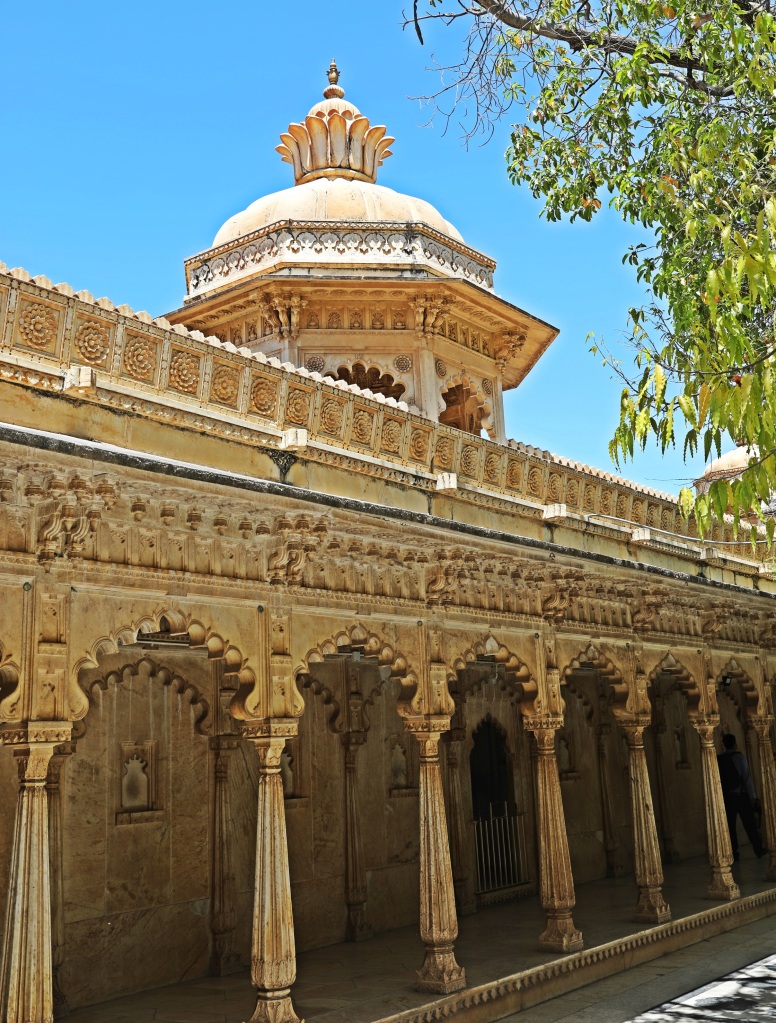
Garden courtyard, Badi Mahal. City Palace, Udaipur 
Marble tub, Badi Mahal, City Palace, Udaipur 
Garden courtyard, Badi Mahal, City Palace, Udaipur 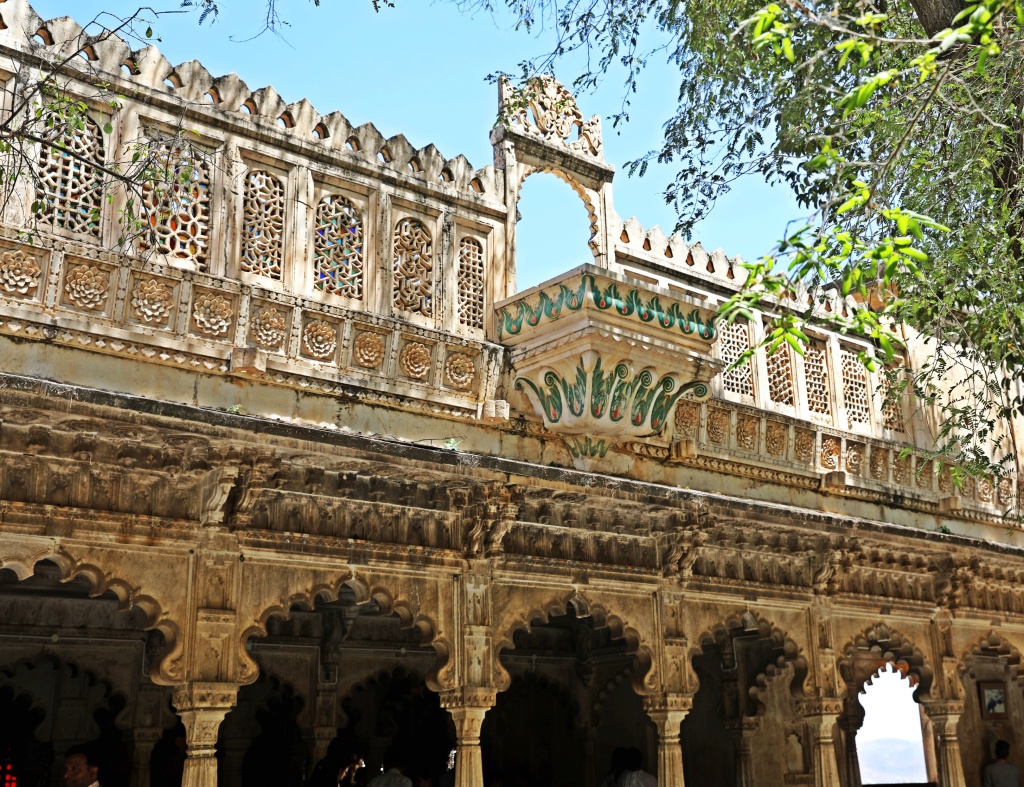
Lovely balcony overlooking garden courtyard, City Palace 
Courtyard with tiled window, City Palace 
Colourful tiles in a courtyard, City Palace, Udaipur 
Balcony overlooking a courtyard, City Palace 
Laxmi Chowk, City Palace 
Pavilion in Laxmi Chowk, City Palace 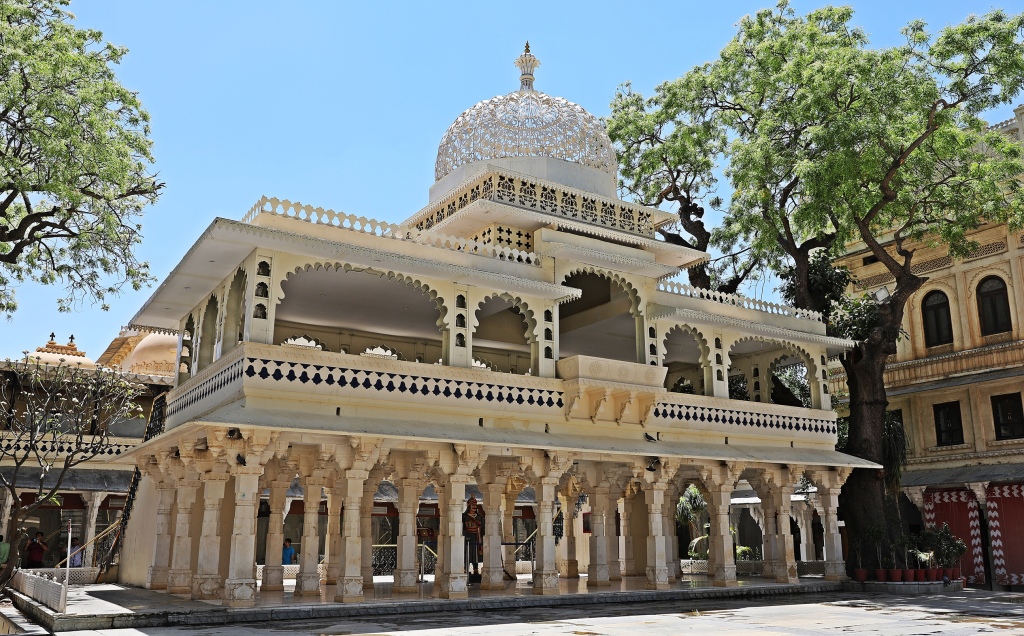
Pavilion in Laxmi Chowk, City Palace 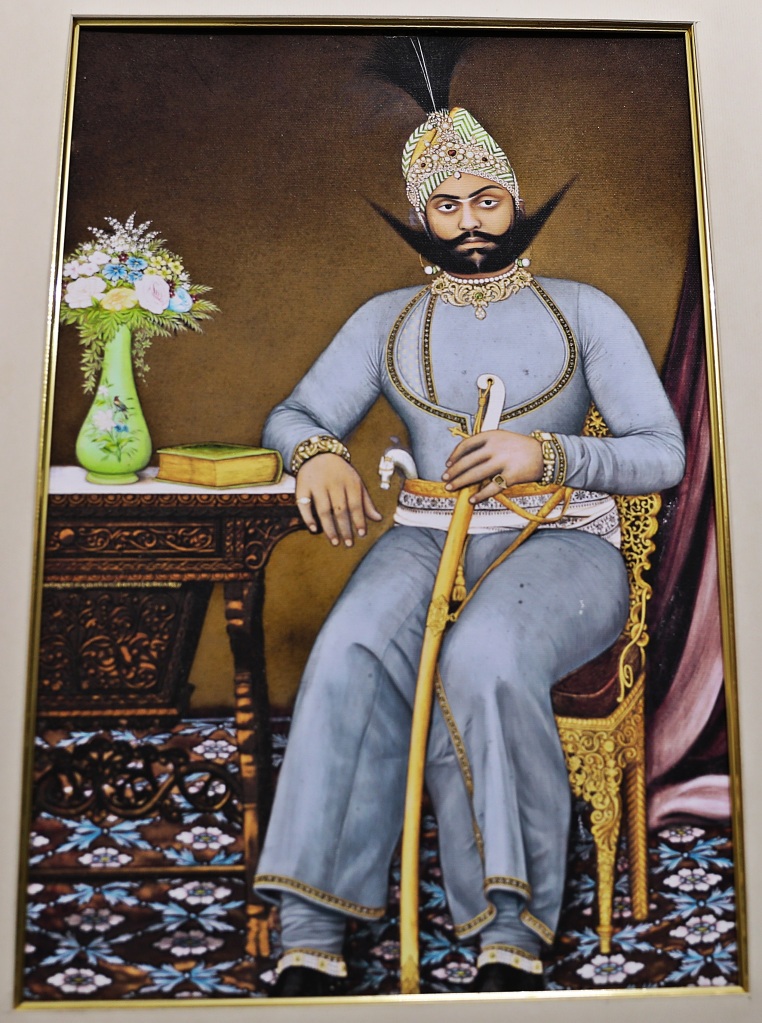
Painting of one of the Maharajas, CIty Palacee
Udaipur is home to many other historical Palaces and Havelis (Rajasthani mansions) that have recently been converted into hotels. Beside City Palace is the 17th century Fateh Prakash Palace Hotel with large turrets and majestic domes. The Maharaja’s family still lives in a part of this palace. Further down is Shiv Niwas Palace with many elaborate balconies and distinctive cupolas and domes on the roof. Beside this hotel is one of many lovely gardens in the city. Set on the side of the lake, its trees offered a respite from the heat. From the garden you can see Lake Palace, an old palace built in the middle of Lake Pichola, giving the appearance that it is floating. At the edge of the lake, Bagore-ki-Haveli has a triple arched entryway to the lake at its base and delicately details windows on top.

Fateh Prakash Palace Hotel, Udaipur 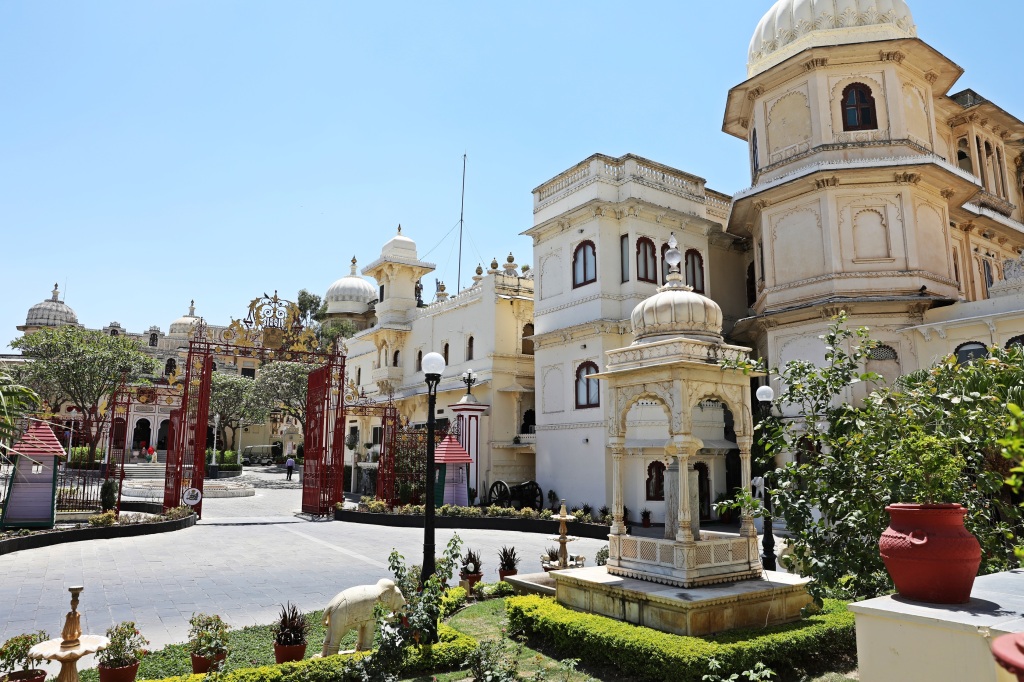
Fateh Prakash Palace Hotel, Udaipur 
Fateh Prakash Palace Hotel on Lake PIchola 
Fateh Prakash Palace Hotel, Udaipur 
Gardens naar City Palace, Udaipur 
Lake Palace on Lake Pichola, Udaipur 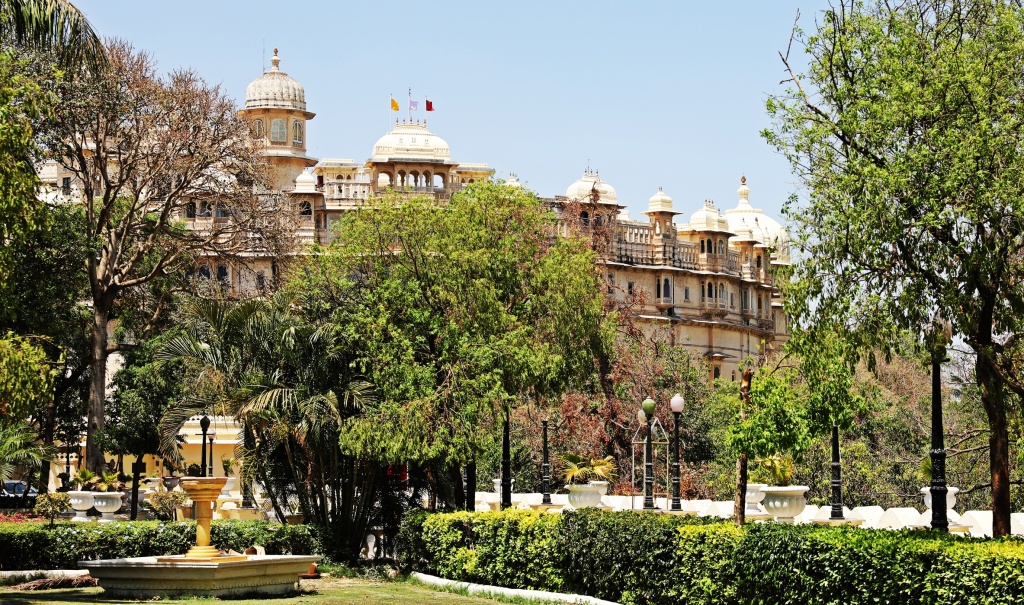
Jagat Niwas Palace Hotel, Udaipur 
Colourful windows, Shiv Niwas Palace Hotel, Udaipur 
Bagore-ki-Haveli 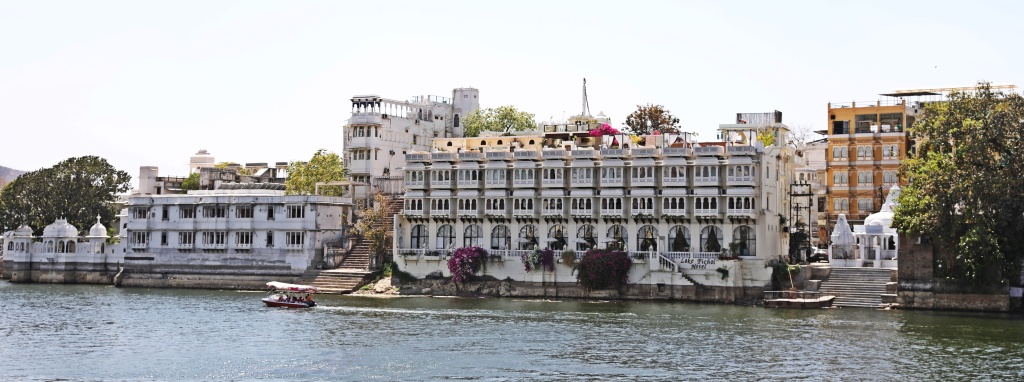
Old Havelis on Lake Pichola 
Haveli, Lake Pichola, Udaipur 
Ghats and City Palace on Lake Pichola 
Haveli, Udaipur
After 18 months on the road, we felt we needed a bit of luxury, so we booked a room at the historical Kotra Haveli Hotel. Havelis are traditional, ornately decorated mansions, typical in Rajasthan. The inner courtyard of our hotel is gorgeous with white pillars, arched doorways and carved windows frames. Our room had a beautiful 4-poster bed and marble floors. The best part was the view of City Palace from the rooftop restaurant. It is the best view in Udaipur.

Courtyard in our hotel, Udaipur 
Dome on the roof of our hotel, Kotra Haveli, Udaipur 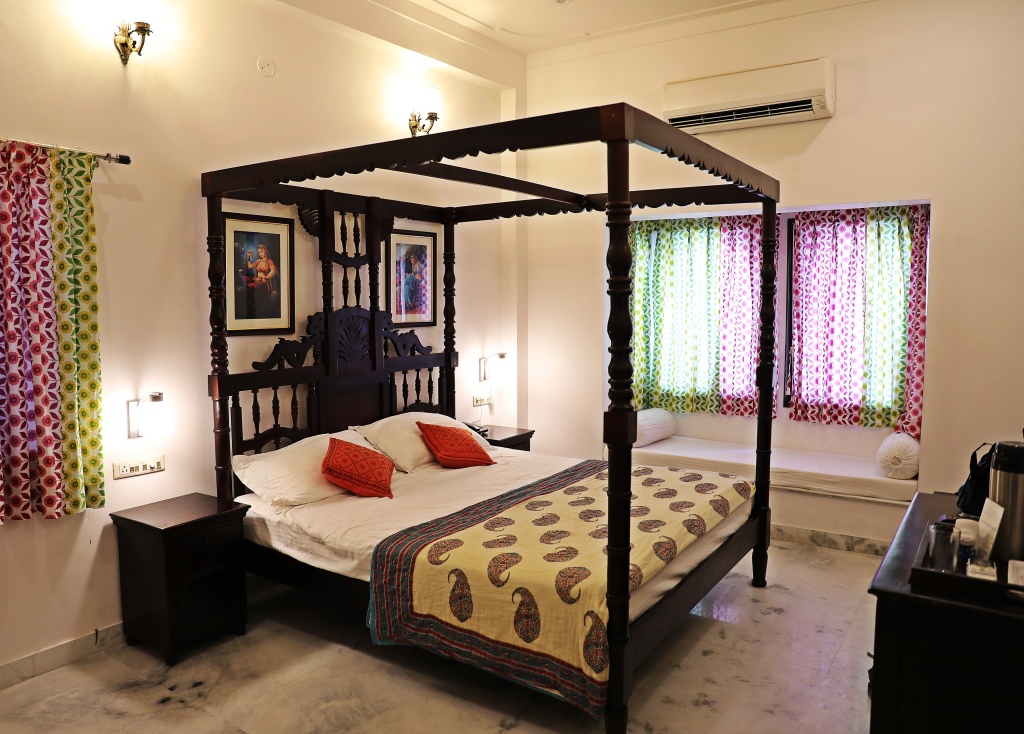
Our bedroom, Kotra Haveli, Udaipur 
Rooftop at night, Udaipur 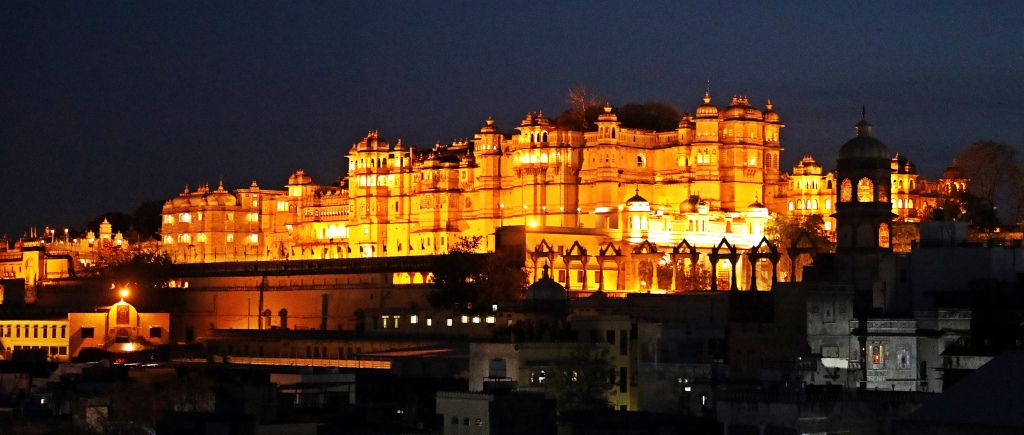
View from our hotel of City Palace at night, Udaipur 
View from our hotel, Jagdish Temple at night, Jaipur
Beside City Palace, atop another small hill, is the 17th century Jagdish Temple. The tall towers are plastered with carvings of Hindu gods, people and animals. The temple is dedicated to Jagannath, an incarnation of the Hindu God Vishnu. There were quite a few beggars at the back of this temple which is something we haven’t seen at a temple in a while.

Jagdish Temple, Udaipur 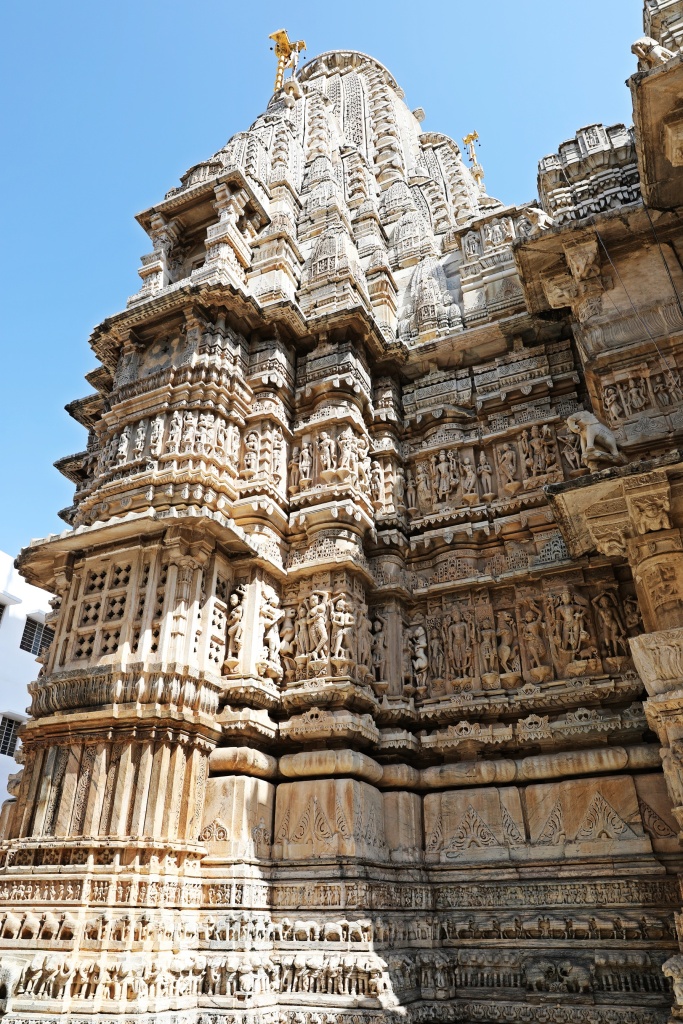
Jagdish Temple, Udaipur 
Carvings on Jagdish Temple, Udaipur 
Jagannath Deity, Udaipur 
Beggars at Jagdish Temple, Udaipur
On a hill outside of town is Monsoon Palace. It was built in the 19th century as an astronomical site and for the Maharaja to watch the monsoon clouds. Today the building is bare, with little of interest, but it does provide nice view of the surrounding, dry Aravalli hills and of Udaipur far below. For a great ending to our day, we watched a playful troupe of Grey Langur monkeys on the trees outside of Monsoon Palace.

Monsoon Palace, Udaipur 
Monsoon Palace, Udaipur 
View from Monsoon Palace 
Monsoon Palace, Udaipur 
Udaipur surrounding Lake Pichola 
Grey Langurs, Monsoon Palace, Udaipur 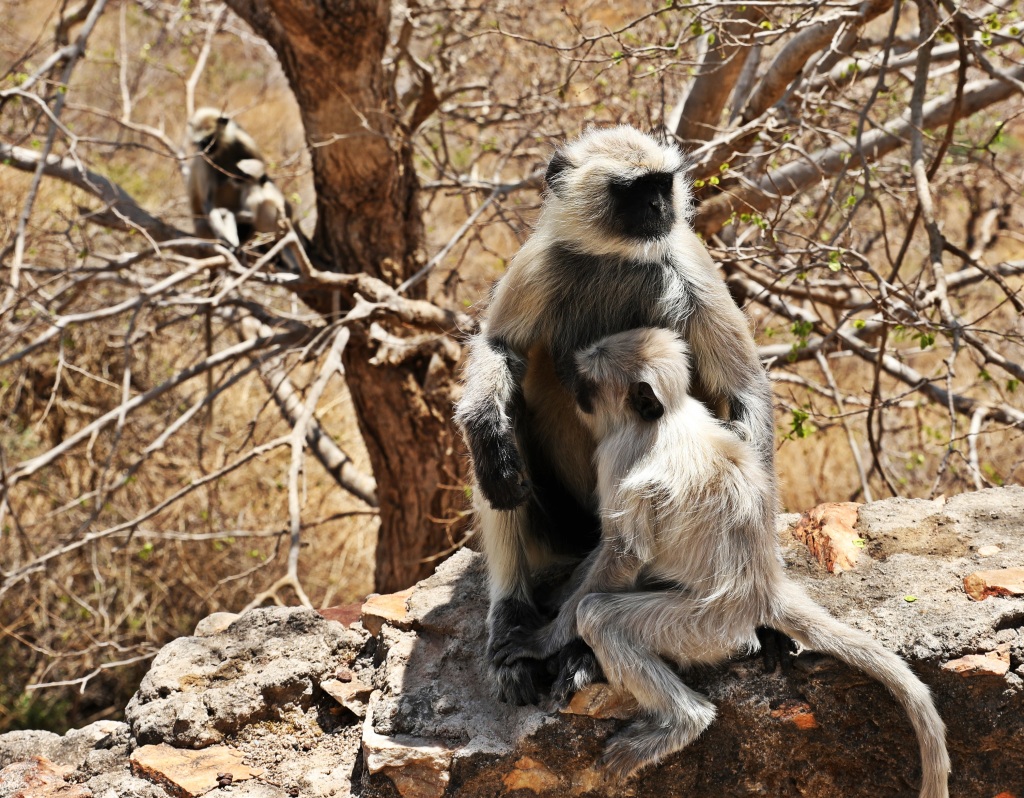
Grey Langurs, Monsoon Palace, Udaipur
Coming up next: Jaisalmer – A Sandcastle In The Desert
For extra pics from this trip go to Gallery/Western India. For extra pictures from other blogs go to Gallery at monkeystale.ca
To read about more of our adventures go to Destinations.
If you like what you read, please comment or share it using the links below.
Great pictures as always!
LikeLiked by 1 person
Thanks!!
LikeLike
Udaipur is a magical place and your photos really take us there. I was lucky enough to visit during a big festival and it was bursting at the seams with energy. Did you watch the James Bond movie in one of the cafes there?
LikeLiked by 1 person
Thanks! I could imagine how amazing it would be there during a festival! I didn’t know about the movie – another one to add to our asian movie-set list!
LikeLike
Isn’t it just the most beautiful place – great photos. We were there in 2013 and loved it.
LikeLiked by 1 person
It was more stunning than we expected. Looking back at the pictures and comparing to other palaces, makes us realize even more how much we loved Udaipur.
LikeLike
Beautiful captures of my home town. 😊
LikeLiked by 1 person
Thanks! What a great hometown! We love Udaipur ☺☺
LikeLike
Wonderful narrative. So much to see. There are so many places in India that I have not been to. Great to see these places through your eyes.
LikeLiked by 1 person
Thank you very much. We were surprised at how many interesting places there are to visit in India. It’s a remarkable country for a tourist.
LikeLike
We have to put a Udaipur on our list for our next visit to India, your photos make it look amazing
LikeLiked by 1 person
Thank you, yes Udaipur turned out to be one of our favourites. It’s definately worth a visit.
LikeLiked by 1 person
There is so much we want to see in India, we have enjoyed every we have visited so far but cant wait to do India with no time constraints, amazing and colourful country
LikeLiked by 1 person
Well, depending on your budget, you should also try to stay in a Haveli. We loved Kotra Haveli (it`s on Booking.com). The rooms were spacious and felt grand, but the best was the rooftop restaurant with the stunning views and the best food in Udaipur. We were budget travelers, so this was a bit more expensive than usual, but considering the room and the views, it was worth it.
LikeLiked by 1 person
Many thanks for the tip, always useful to gather information
LikeLiked by 1 person
If you haven’t already, take a look at our India pages
LikeLiked by 1 person
For some reason I wasn’t able to comment on your India blog, maybe an internet problem. You did a lot in 2 weeks and experienced the highs and lows of India, which is what makes it great! We spent 8 months in India so if you do go back check out our blog or email us any questions.
LikeLiked by 1 person
Hi there, I will check page out to see if there is a problem our end. Many thanks for looking, it needs 8 months! Will certainly check out your blog when we go back😀
LikeLiked by 1 person
You have captured some great images 🙂
LikeLiked by 1 person
Thank you, it’s also a very photogenic area😊
LikeLiked by 1 person
This is an overwhelming post (in a good way). The majesty and intricate detail is almost too much to take in. I’m glad you guys gave yourself a little splurge. Now I’ll have to patiently go through all your India posts again and narrow down what an India visit will look like for us. I’ve just loved (and continue to love) your journey. When are you home?
LikeLiked by 1 person
Thanks Caroline, Udaipur and in fact most of Rajasthan has incredible architecture. Even though it was the end of our trip, we thoroughly enjoyed it. We arrived home a couple of days ago, but I still have a month’s worth of blogs. Don’t hesitate to contact us for info on your India trip!
LikeLiked by 1 person
Welcome home! It must be a crazy mixed bag of emotions after being away for so long. We don’t have dates yet for India but I’m sure I’ll be in contact.
LikeLiked by 1 person
It is a mixed bag, but it’s mostly good! Certainly no regrets on coming home.
LikeLike
Wow, this brought back such wonderful memories. We’re yet to find a city that can replace Udaipur as our favourite one in India. 🙂
LikeLiked by 1 person
Thanks! We love Udaipur too. It was our first city in Rajasthan, so we compared the rest to it and they didn’t knock it off our number 1 ranking.
LikeLike